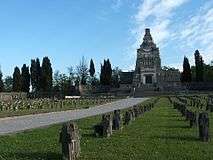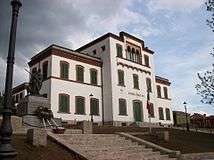Crespi d'Adda
Crespi d'Adda is a northern Italian village and hamlet (frazione) of Capriate San Gervasio, a municipality in the province of Bergamo, Lombardy. It is a historic settlement and an outstanding example of the 19th and early 20th-century "company towns" built in Europe and North America by enlightened industrialists to meet the workers' needs. The site is still intact and is partly used for industrial purposes, although changing economic and social conditions now threaten its survival.[3] Since 1995 it has been on UNESCO's list of World Heritage Sites.
Crespi d'Adda | |
|---|---|
The town's company-built school, church and employee houses | |
 Crespi d'Adda Location of Crespi d'Adda in Italy | |
| Coordinates: 45°35′48″N 9°32′10″E | |
| Country | |
| Region | |
| Province | Bergamo (BG) |
| Comune | Capriate San Gervasio |
| Elevation | 465 m (1,526 ft) |
| Population (2011)[1] | |
| • Total | 397 |
| Demonym(s) | Casalesi |
| Time zone | UTC+1 (CET) |
| • Summer (DST) | UTC+2 (CEST) |
| Postal code | 84070[2] |
| Dialing code | (+39) 0974 |
| Patron saint | Saint Maurus |
| Website | Official website |
| Criteria | Cultural: iv, v |
| Reference | 730 |
| Inscription | 1995 (19th session) |
History
19th century
.jpg)
In 1869 Cristoforo Benigno Crespi, a textile manufacturer from Busto Arsizio (Varese), bought the 1 km valley between the rivers Brembo and Adda, to the south of Capriate, with the intention of installing a cotton mill on the banks of the Adda.[4]
Cristoforo Crespi introduced the most modern spinning, weaving and finishing processes in his Cotton Mill.[5] The Hydroelectric power plant in Trezzo, on the Adda river just a few kilometers upwards, was built up around 1906 for the manufacturer Cristoforo Benigno Crespi.[6] The settlement which was built in 1878 next to the cotton-mill was a village, a residential area provided with social services such as a clinic, a school building, a theatre, a cemetery, a wash-house and a church.[7][8]
Both the town and the factory were illuminated thanks to electric light.[9] The village of Crespi d'Adda was the first village in Italy to have modern public lighting.[10] The workers houses, of English inspiration, are lined up in order along parallel roads to the East of the factory.[5] A tree-lined avenue separates the production zone from the houses, overlooking a chequer-board road plan.[11] The whole architecture and town planning (except the first spinning department, created by engineer Angelo Colla), was submitted to the architect Ernesto Pirovano. For about fifty years Pirovano, helped by the engineer Pietro Brunati, ran the construction of the village.[9] model shops toy-like constructions / miniatures had been made to educate and exemplify new trends in social thinking and scientific advances to the inhabitants in the form of suitcases that contained them ...
In 1889 the son of Cristoforo, Silvio Benigno Crespi, started work in the factory as a director, after spending time in Oldham, England.[9] He turned away from the large multiple-occupancy blocks in favour of the single-family house, with its own garden, which he saw as conducive to harmony and a defence against industrial strife. He put this policy into practice in 1892 and the years that followed, with success, since there was no strike or other form of social disorder for the fifty years of Crespi management.[4]
20th century
The Great Depression of 1929 and the harsh fascist fiscal policy resulted in the Crespi family being obliged to sell the entire town to STI, the Italian textile enterprise, which transferred it to the Rossarl e Varzi company in 1970. It then passed to the Legler company, which sold off most of the houses. It was last in the hands of the Polli industrial group, which employed some 600 people, as compared with the 3200 employed during the years of maximum activity.[4]
21st century
Today the village is inhabited by a community largely descended from the original workers. The factory stopped production only in 2004, its field of activity throughout its working life having been cotton textile production.
In October 2013, it was announced that Antonio Percassi was purchasing Crespi d'Adda in order to convert into the headquarters for the Percassi Business group as well as the headquarters for the new Antonio Percassi Family Foundation.[12]
Geography
The village is located by the eastern shore of the river Adda, next to the provincial borders of Bergamo with Milan, south of Capriate San Gervasio. Other nearest settlements are Trezzo sull'Adda, Brembate, Vaprio d'Adda and Canonica d'Adda.[13] It is 19 km from Bergamo and its airport, 30 km from Monza and 47 km from Milan. Nearest motorway exit, "Capriate", is 2 km north and is part of the A4 motorway Turin-Trieste.
Gallery
 Cemetery of Crespi d'Adda
Cemetery of Crespi d'Adda.jpg) View of the cotton mill
View of the cotton mill
.jpg) A factory worker’s house with garden.
A factory worker’s house with garden. Village school
Village school
See also
- Model village
- Derwent Valley Mills, a similar World Heritage Site in Derbyshire, England whose first cotton mill was built in 1771.
References
- (in Italian) Casalsottano on italia.indettaglio.it
- (in Italian) Italian postal code 84070 (tuttocitta.it)
- UNESCO Reference 730
- Info at db.formez.it Archived 2008-05-30 at the Wayback Machine
- Value And History Of The Village Of Crespi D'Adda Archived 2008-11-05 at the Wayback Machine
- www.laviadellenergia.it - Territory - Territorial Policies - Taccani Hydroelectric Power Station, Trezzo d'Adda, Milano Archived 2008-10-05 at the Wayback Machine
- (in Italian) Crespi d'Adda website
- Crespi d'Adda - World Heritage Site - Pictures, info and travel reports
- Crespi d'Adda
- What Is Crespi D'Adda? Archived 2007-09-28 at the Wayback Machine
- (in Italian) Info on apt.bergamo.it Archived 2008-05-30 at the Wayback Machine
- Info at percassi.it Archived 2013-12-21 at the Wayback Machine
- 409048659 Crespi d'Adda on OpenStreetMap
External links
| Wikimedia Commons has media related to Crespi d'Adda. |
- (in Italian) Crespi d'Adda website
- Villaggio Crespi (Crespi Workers' Village)
- Crespi d'Adda UNESCO - The official website
- Official Unesco Photo gallery
